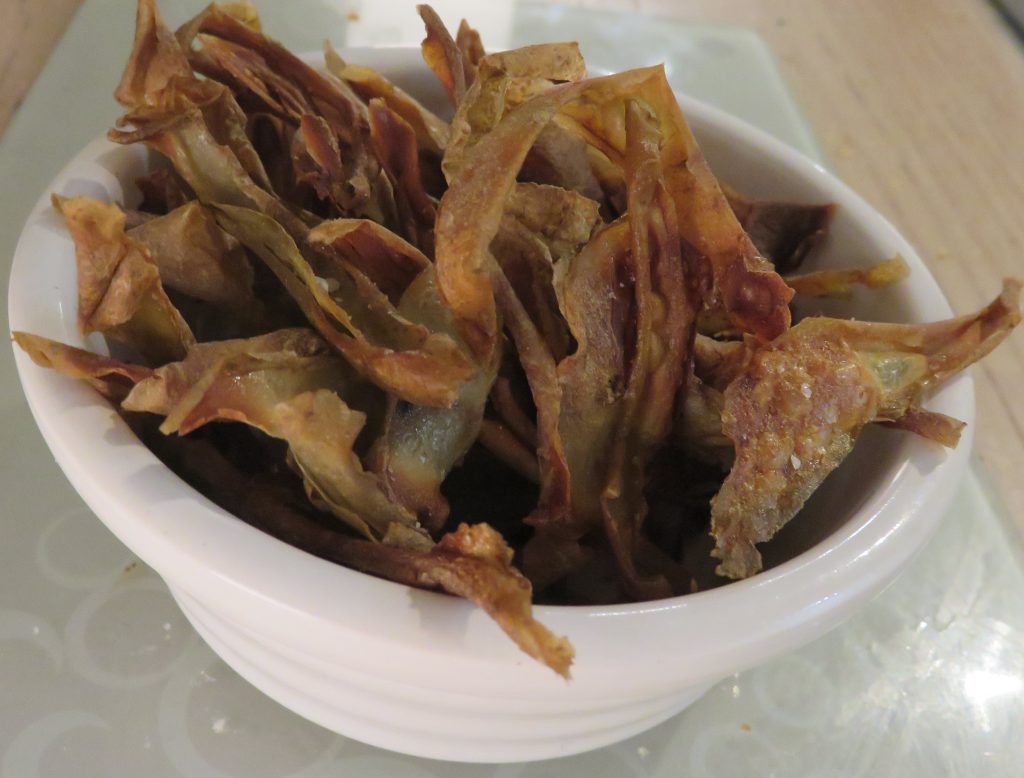
According to the Love food hate waste website one-third of the food produced globally goes to waste, with an estimated 10 million tonnes of food waste being produced in the UK each year, 70% of that coming from our homes. If one adds the environmental cost of food production into the equation, then there has never been a better time to spare both our wallets and the planet. A BBC article on how to eat sustainably identifies many ways to save food waste but many of us are simply ignoring the skins, leaves and stalks of fruit and vegetables, which are coincidentally often said to have the most vitamins and fibre.
‘Compleating’, or whole plant cooking, defined as making use of the whole fruit or vegetable without wasting any edible part, is becoming increasingly popular. Most of us wouldn’t think about peeling an apple these days but there are many other fruits for which the peel can be eaten or cooked. Modern kiwi fruit for instance, are much more smooth skinned these days and I have longed stop peeling them. An added bonus is that eating the skin triples their fibre content.
Citrus fruits are ideal candidates for compleating. I buy unwaxed lemons or remove the wax by pouring boiling water over the lemon or putting the lemon in the microwave for 10 seconds before scrubbing with a pan scrub. Spare juice can be frozen and if I don’t need the zest of a lemon for a recipe, I zest the lemon before squeezing it and freeze the zest. It will keep for up to six months and can be used straight from frozen. Use 1.5 teaspoons for every 1 teaspoon of fresh zest
Seville marmalade must be the ultimate compleat preserve but you can also make a quick fridge jam using oranges left over from juicing. I freeze the juiced halves until I have enough: they will keep for six months in the freezer. If you prefer something more spicy, the Guardian has a recipe for water melon rind pickle.
In the summer, I make Delia Smith’s pineapple cooler which is a slightly fizzy fruity drink made by allowing the pineapple rind to ferment in cold water for 3-4 days until bubbly.
Finally, if lockdown has left you tired of banana bread, try Tesco’s banana peel cake, part of a series of root to stem recipes designed to cut waste. If you prefer something savoury, you can make a “pulled pork” style from banana skins. You basically shred a banana skin by pulling a fork across it, add to sweated onions and a piquant tomato sauce (I have tried it with a homemade blackberry ketchup) and cook down until soft. You will find plenty or recipes on the internet.
Vegetables can also be successfully compleated. If I can, I buy my fresh beetroot with nice fresh tops (a good sign that the beetroot is still fresh) and sweat them like swiss chard, or you can try the sustainable chef Tom Hunt’s recipe for beetroot leaves dip. More recipes by Tom can be found on his website and he has recently launched a book: Eating for pleasure, people & planet which mixes recipes with commentary on a sustainable food system. I have also tried sauteing radish leaves but as they can be hairy, I prefer to add them to soups where they get cooked long enough to soften them. Country Broccoli is a good recipe to use up all the parts of broccoli, carrots and onions.
Crispy potato peelings are my lockdown discovery. While I often leave potatoes unpeeled as rustic potato wedges, sometimes one just needs mashed potato. If you have the oven on, just place the peelings on a baking tray with a bit of olive oil and cook in the oven until crisp. Salt or season with spices or herbs and eat while still hot and crispy.
Cauliflower leaves are another vegetable that you can crisp in the oven. Cut the smaller cauliflower leaves into thin strips, coat with a little olive oil and bake in the oven so that they crisp up like the “seaweed” you get from a Chinese take-away. Add soy sauce to taste.
Toasted squash seeds make another great pre-dinner treat. Wash the seeds of a butternut squash to free them of the pulp that you have just scooped out, pat dry and place in a baking tray with a little oil and cook until crisp. Salt or season with spices and eat as a snack or use to garnish your cooked squash dish.
Finally any bits of vegetables that you don’t want to use can go into stock or soup . I always put aside the celery leaves and the green parts of leeks or spring onions for soup. A search on the internet will reveal lots of recipes for “scrap soup” made out of vegetable stalks and peelings which can be stored in a freezer bag in the freezer until there are sufficient to make a stock or soup. And many Italian cooks swear that the leftover rind of a parmesan wedge put into minestrone soup makes all the difference.